BIPRU 8
Group risk consolidation
BIPRU 8.1
Application
- 01/01/2007
BIPRU 8.1.1
See Notes

This chapter applies to:
- (1) a BIPRU firm that is a member of a UK consolidation group;
- (2) a BIPRU firm that is a member of a non-EEA sub-group;
- (3) an ELMI that is a member of a UK consolidation group or non-EEA sub-group if that group includes a BIPRU firm; and
- (4) a firm that is not a BIPRU firm and is a parent financial holding company in a Member State in a UK consolidation group.
- 01/01/2007
BIPRU 8.1.2
See Notes

- 01/01/2007
Purpose
BIPRU 8.1.3
See Notes

- 01/01/2007
How this chapter is organised
BIPRU 8.1.4
See Notes

- 01/01/2007
BIPRU 8.1.5
See Notes

- 01/01/2007
BIPRU 8.1.6
See Notes

- 01/01/2007
BIPRU 8.1.7
See Notes

- 01/01/2007
BIPRU 8.1.8
See Notes

- 01/01/2007
BIPRU 8.1.9
See Notes

- 01/01/2007
BIPRU 8.1.10
See Notes

- 01/01/2007
BIPRU 8.1.11
See Notes

- 01/01/2007
Consolidation requirements for BIPRU firms elsewhere in the Handbook
BIPRU 8.1.12
See Notes

- 01/01/2007
BIPRU 8.1.13
See Notes

- 01/01/2007
BIPRU 8.1.14
See Notes

- 01/01/2007
BIPRU 8.1.15
See Notes

- 01/01/2007
BIPRU 8.1.16
See Notes

- 01/01/2007
BIPRU 8.2
Scope and basic consolidation requirements for UK consolidation groups
- 01/01/2007
Main consolidation rule for UK consolidation groups
BIPRU 8.2.1
See Notes

A firm that is a member of a UK consolidation group must comply, to the extent and in the manner prescribed in BIPRU 8.5, with the obligations laid down in GENPRU 1.2 (Adequacy of financial resources), the main BIPRU firm Pillar 1 rules (but not the base capital resources requirement) and BIPRU 10 (Concentration risk requirements) on the basis of the consolidated financial position of:
- (1) where either Test 1A or Test 1B in BIPRU 8 Annex 1 (Decision tree identifying a UK consolidation group) apply, the parent institution in a Member State in the UK consolidation group; or
- (2) where either Test 1C or Test 1D in BIPRU 8 Annex 1 apply, the parent financial holding company in a Member State.
- 01/01/2007
BIPRU 8.2.2
See Notes

- 01/01/2007
BIPRU 8.2.3
See Notes

- 01/01/2007
Definition of UK consolidation group
BIPRU 8.2.4
See Notes

A firm's UK consolidation group means a group that is identified as a UK consolidation group in accordance with the decision tree in BIPRU 8 Annex 1 R (Decision tree identifying a UK consolidation group); the members of that group are:
- (1) where either Test 1A or Test 1B in BIPRU 8 Annex 1 R apply, the members of the consolidation group made up of the sub-group of the parent institution in a Member State identified in BIPRU 8 Annex 1 R together with any other person who is a member of that consolidation group because of a consolidation Article 12(1) relationship or an Article 134 relationship; or
- (2) where either Test 1C or Test 1D in BIPRU 8 Annex 1 R apply, the members of the consolidation group made up of the sub-group of the parent financial holding company in a Member State identified in BIPRU 8 Annex 1 R together with any other person who is a member of that consolidation group because of a consolidation Article 12(1) relationship or an Article 134 relationship;
in each case only persons included under BIPRU 8.5 (Basis of consolidation) are included in the UK consolidation group.
- 06/04/2007
BIPRU 8.2.5
See Notes

- 01/01/2007
BIPRU 8.2.6
See Notes

- 01/01/2007
BIPRU 8.2.7
See Notes

- 01/01/2007
BIPRU 8.3
Scope and basic consolidation requirements for non-EEA sub-groups
- 01/01/2007
Main consolidation rule for non-EEA sub-groups
BIPRU 8.3.1
See Notes

- (1) A BIPRU firm that is a subsidiary undertaking of a BIPRU firm or of a financial holding company must apply the requirements laid down in GENPRU 1.2 (Adequacy of financial resources), the main BIPRU firm Pillar 1 rules (but not the base capital resources requirement) and BIPRU 10 (Concentration risk requirements) on a sub-consolidated basis if the BIPRU firm, or the parent undertaking where it is a financial holding company, have a third country banking or investment services undertaking as a subsidiary undertaking or hold a participation in such an undertaking.
- (2) (1) only applies if the FSA is required by the Banking Consolidation Directive or the Capital Adequacy Directive to supervise the group established under (1) under Article 73(2) of the Banking Consolidation Directive (Non-EEA sub-groups).
- 01/01/2007
BIPRU 8.3.2
See Notes

- 01/01/2007
BIPRU 8.3.3
See Notes

- 01/01/2007
BIPRU 8.3.4
See Notes

- 01/01/2007
How to identify a non-EEA sub-group
BIPRU 8.3.5
See Notes

- 01/01/2007
BIPRU 8.3.6
See Notes

- 01/01/2007
BIPRU 8.3.7
See Notes

A firm will not be a member of a non-EEA sub-group unless it is also a member of a UK consolidation group. So the first step is to identify each undertaking in the firm's UK consolidation group that satisfies the following conditions:
- (1) it is an institution, financial institution or asset management company whose head office is outside the EEA (a third country banking or investment services undertaking);
- (2) one of the following applies:
- (a) it is a subsidiary undertaking of a BIPRU firm in that UK consolidation group; or
- (b) a BIPRU firm in that UK consolidation group holds a participation in it; and
- (3) that BIPRU firm is not a parent institution in a Member State.
- 01/01/2007
BIPRU 8.3.8
See Notes

- 01/01/2007
BIPRU 8.3.9
See Notes

- 01/01/2007
BIPRU 8.3.10
See Notes

- 01/01/2007
BIPRU 8.3.11
See Notes

- 01/01/2007
BIPRU 8.3.12
See Notes

The firm should then identify each undertaking in the firm's UK consolidation group that satisfies the following conditions:
- (1) it is an institution, financial institution or asset management company whose head office is outside the EEA (a third country banking or investment services undertaking);
- (2) one of the following applies:
- (a) it is a subsidiary undertaking of a financial holding company in that UK consolidation group; or
- (b) a financial holding company in that UK consolidation group holds a participation in it;
- (3) the head office of that financial holding company is in the United Kingdom; and
- (4) that financial holding company has a subsidiary undertaking that is a BIPRU firm.
- 01/01/2007
BIPRU 8.3.13
See Notes

- 01/01/2007
BIPRU 8.3.14
See Notes

- 01/01/2007
BIPRU 8.3.15
See Notes

- 01/01/2007
BIPRU 8.3.16
See Notes

- 01/01/2007
BIPRU 8.3.17
See Notes

- 01/01/2007
BIPRU 8.3.18
See Notes

Having identified potential non-EEA sub-groups for each third country banking or investment services undertaking in its UK consolidation group the firm should then eliminate overlapping potential non-EEA sub-groups in the following way. If:
- (1) one potential non-EEA sub-group is contained within a wider potential non-EEA sub-group; and
- (2) the third country banking or investment services undertakings in the two potential non-EEA sub-groups are the same;
then the smaller potential non-EEA sub-group is eliminated.
- 01/01/2007
BIPRU 8.3.19
See Notes

- 01/01/2007
BIPRU 8.3.20
See Notes

- 01/01/2007
BIPRU 8.3.21
See Notes

- 01/01/2007
BIPRU 8.3.22
See Notes

- 01/01/2007
BIPRU 8.3.23
See Notes

- 01/01/2007
BIPRU 8.3.24
See Notes

- 01/01/2007
BIPRU 8.4
CAD Article 22 groups and investment firm consolidation waiver
- 01/01/2007
Application
BIPRU 8.4.1
See Notes

- 01/01/2007
The effect of an investment firm consolidation waiver and the conditions for getting one
BIPRU 8.4.2
See Notes

- 01/01/2007
BIPRU 8.4.3
See Notes

- 01/01/2007
BIPRU 8.4.4
See Notes

The FSA will not grant an investment firm consolidation waiver unless:
- (1) the UK consolidation group or non-EEA sub-group meets the conditions for being a CAD Article 22 group;
- (2) the FSA is satisfied that each BIPRU firm in the UK consolidation group or non-EEA sub-group will be able to meet its capital requirements using the calculation of capital resources in GENPRU 2 Annex 6 (Capital resources table for a BIPRU investment firm with a waiver from consolidated supervision); and
- (3) the firm demonstrates that the requirements in BIPRU 8.4.11 R to BIPRU 8.4.18 R will be met.
- 01/01/2007
BIPRU 8.4.5
See Notes

- 01/01/2007
BIPRU 8.4.6
See Notes

- 01/01/2007
Meeting the terms of an investment firm consolidation waiver
BIPRU 8.4.7
See Notes

- 01/01/2007
BIPRU 8.4.8
See Notes

- 01/01/2007
Definition of a CAD Article 22 group
BIPRU 8.4.9
See Notes

- (1) A CAD Article 22 group means a UK consolidation group or non-EEA sub-group that meets the conditions in this rule.
- (2) There must be no bank, building society or credit institution in the UK consolidation group or non-EEA sub-group.
- (3) Each CAD investment firm in the UK consolidation group or non-EEA sub-group which is an EEA firm must use the definition of own funds given in the CRD implementation measure of its EEA State for Article 16 of the Capital Adequacy Directive.
- (4) Each CAD investment firm in the UK consolidation group or non-EEA sub-group must be a:
- (a) limited activity firm; or
- (b) limited licence firm.
- (5) Each CAD investment firm in the UK consolidation group or non-EEA sub-group which is an EEA firm must:
- (a) meet the requirements imposed by the CRD implementation measures of its EEA State for Articles 18 and Article 20 of the Capital Adequacy Directive on an individual basis; and
- (b) deduct from its own funds any contingent liability in favour of other members of the UK consolidation group or non-EEA sub-group.
- (6) Each BIPRU investment firm in the UK consolidation group or non-EEA sub-group must comply with the main BIPRU firm Pillar 1 rules on an individual basis.
- 01/01/2007
BIPRU 8.4.10
See Notes

- 01/01/2007
Capital adequacy obligations relating to a CAD Article 22 group: General rule
BIPRU 8.4.11
See Notes

If a firm has an investment firm consolidation waiver, it must ensure that any financial holding company in the UK consolidation group or the non-EEA sub-group that is the UK parent financial holding company in a Member State of a CAD investment firm in the UK consolidation group or non-EEA sub-group has capital resources, calculated under BIPRU 8.4.12 R, in excess of the sum of the following (or any higher amount specified in the investment firm consolidation waiver):
- (1) the sum of the solo notional capital resources requirements for each CAD investment firm, financial institution, asset management company and ancillary services undertaking in the UK consolidation group or the non-EEA sub-group, as calculated in accordance with BIPRU 8.4.13 R; and
- (2) the total amount of any contingent liability in favour of CAD investment firms, financial institutions, asset management companies and ancillary services undertakings in the UK consolidation group or non-EEA sub-group.
- 01/01/2007
Capital adequacy obligations relating to a CAD Article 22 group: Capital resources
BIPRU 8.4.12
See Notes

A firm must calculate the capital resources of the parent financial holding company in a Member State for the purpose of BIPRU 8.4.11 R as follows:
- (1) the capital resources are the sum of capital resources calculated at stages D (Total tier one capital before deductions) and I (Total tier two capital) of the version of the capital resources table in GENPRU 2 Annex 4 (Capital resources table for a BIPRU investment firm deducting material holdings) as adjusted in accordance with this rule;
- (2) capital resources at stage D must not include innovative tier one capital resources, but they may be included at stage I if (5) allows this;
- (3) the amount of the items which may be included at stage I must not exceed the amount calculated at stage D of the capital resources table;
- (4) the amount of the items which may be included in lower tier two capital in stage I must not exceed 50% of the amount calculated at stage D of the capital resources table; and
- (5) GENPRU 2.2.25 R (Limits on the use of different forms of capital: Use of higher tier capital in lower tiers) and GENPRU 2.2.27 R (Use of innovative tier one capital in lower stages of capital) apply.
- 01/01/2007
Capital adequacy obligations relating to a CAD Article 22 group: Capital resources requirement
BIPRU 8.4.13
See Notes

The solo notional capital resources requirement as referred to in BIPRU 8.4.11R (1) is calculated in the same way as:
- (1) (if each CAD investment firm in the UK consolidation group or non-EEA sub-group is a limited licence firm) the capital resources requirement for a BIPRU limited licence firm; or
- (2) (in any other case) the capital resources requirement for a BIPRU limited activity firm.
- 01/01/2007
BIPRU 8.4.14
See Notes

- 01/01/2007
BIPRU 8.4.15
See Notes

- 01/01/2007
BIPRU 8.4.16
See Notes

- 01/01/2007
Capital adequacy obligations relating to a CAD Article 22 group: Advanced prudential calculation approaches
BIPRU 8.4.17
See Notes

- 01/01/2007
Additional rules that apply to a firm with an investment firm consolidation waiver
BIPRU 8.4.18
See Notes

If a firm has an investment firm consolidation waiver, it must:
- (1) ensure that each CAD investment firm in the UK consolidation group or non-EEA sub-group which is a firm or an EEA firm has in place systems to monitor and control the sources of capital and funding of all the members in the UK consolidation group or non-EEA sub-group;
- (2) notify the FSA of any serious risk that could undermine the financial stability of the UK consolidation group or non-EEA sub-group, as soon as the firm becomes aware of that risk, including those associated with the composition and sources of the capital and funding of members of the UK consolidation group or non-EEA sub-group;
- (3) report the amount of the consolidated capital resources and consolidated capital resources requirement of the UK consolidation group or non-EEA sub-group on a periodic basis as set out in the investment firm consolidation waiver;
- (4) report any large exposures risks of members of the UK consolidation group or non-EEA sub-group including any undertakings not located in an EEA State on a periodic basis set out in the investment firm consolidation waiver;
- (5) notify the FSA immediately it becomes aware that the UK consolidation group or non-EEA sub-group has ceased to meet the conditions for being a CAD Article 22 group; and
- (6) notify the FSA immediately it becomes aware of any breach of BIPRU 8.4.11 R.
- 01/01/2007
BIPRU 8.4.19
See Notes

- 01/01/2007
BIPRU 8.5
Basis of consolidation
- 01/01/2007
Undertakings to be included in consolidation
BIPRU 8.5.1
See Notes

A firm must include only the following types of undertaking in a UK consolidation group or non-EEA sub-group for the purposes of this chapter:
- (1) a BIPRU firm;
- (2) an institution;
- (3) a financial institution;
- (4) an asset management company;
- (5) a financial holding company; and
- (6) an ancillary services undertaking.
- 01/01/2007
BIPRU 8.5.2
See Notes

- 01/01/2007
BIPRU 8.5.3
See Notes

- 01/01/2007
Basis of inclusion of undertakings in consolidation
BIPRU 8.5.4
See Notes

- 01/01/2007
BIPRU 8.5.5
See Notes

In carrying out the calculations for the purposes of this chapter a firm must only include the relevant proportion of an undertaking that is a member of the UK consolidation group or non-EEA sub-group:
- (1) by virtue of a consolidation Article 12(1) relationship;
- (2) by virtue of an Article 134 relationship; or
- (3) because the group holds a participation in it.
- 01/01/2007
BIPRU 8.5.6
See Notes

In BIPRU 8.5.5 R, the relevant proportion is either:
- (1) (in the case of a participation) the proportion of shares issued by the undertaking held by the UK consolidation group or the non-EEA sub-group; or
- (2) (in the case of a consolidation Article 12(1) relationship or an Article 134 relationship), such proportion (if any) as stated in the Part IV permission of the firm.
- 01/01/2007
Basis of inclusion of UCITS investment firms in consolidation
BIPRU 8.5.7
See Notes

- 01/01/2007
BIPRU 8.5.8
See Notes

- 01/01/2007
Exclusion of undertakings from consolidation: Balance sheet size
BIPRU 8.5.9
See Notes

A firm may, having first notified the FSA in writing in accordance with SUP 15.7 (Form and method of notification), exclude an institution, asset management company, financial institution or ancillary services undertaking that is a subsidiary undertaking in, or an undertaking in which a participation is held by, the UK consolidation group or non-EEA sub-group if the balance sheet total of that undertaking is less than the smaller of the following two amounts:
- (1) 10 million Euros;
- (2) 1% of the balance sheet total of the parent undertaking or the undertaking that holds the participation.
- 01/01/2007
BIPRU 8.5.10
See Notes

- 01/01/2007
Exclusion of undertakings from consolidation: Other reasons
BIPRU 8.5.11
See Notes

Article 73(1) of the Banking Consolidation Directive allows the FSA to decide to exclude an institution, financial institution, asset management company or ancillary services undertaking that is a subsidiary undertaking in, or an undertaking in which a participation is held by, the UK consolidation group or non-EEA sub-group for the purposes of this chapter in the following circumstances:
- (1) where the head office of the undertaking concerned is situated in a country outside the EEA where there are legal impediments to the transfer of the necessary information; or
- (2) where, in the opinion of the FSA, the undertaking concerned is of negligible interest only with respect to the objectives of monitoring institutions; or
- (3) where, in the opinion of the FSA, the consolidation of the financial situation of the undertaking concerned would be inappropriate or misleading as far as the objectives of the supervision of institutions are concerned.
- 01/01/2007
BIPRU 8.5.12
See Notes

- 01/01/2007
BIPRU 8.5.13
See Notes

- 01/01/2007
Information about excluded undertakings
BIPRU 8.5.14
See Notes

- 01/01/2007
BIPRU 8.6
Consolidated capital resources
- 01/01/2007
General
BIPRU 8.6.1
See Notes

- 01/01/2007
Limits on the use of different forms of capital
BIPRU 8.6.2
See Notes

- 01/01/2007
BIPRU 8.6.3
See Notes

- 01/01/2007
BIPRU 8.6.4
See Notes

- 01/01/2007
BIPRU 8.6.5
See Notes

- 01/01/2007
Calculation of consolidated capital resources if there is a building society in the group
BIPRU 8.6.6
See Notes

- 01/01/2007
Calculation of consolidated capital resources if there is a bank or credit institution in the group
BIPRU 8.6.7
See Notes

- 01/01/2007
Calculation of consolidated capital resources for an investment firm group
BIPRU 8.6.8
See Notes

- 01/01/2007
BIPRU 8.6.9
See Notes

- 01/01/2007
Treatment of minority interests
BIPRU 8.6.10
See Notes

- (1) This rule sets out how to determine whether minority interests in an undertaking in a UK consolidation group or non-EEA sub-group may be included in tier one capital, tier two capital or tier three capital for the purpose of calculating consolidated capital resources (each referred to as a "tier" of capital in this rule).
- (2) A firm must identify the item of capital of the undertaking in question that gives rise to that minority interest.
- (3) A firm must include the minority interest in the tier of capital in which that undertaking would have to include the capital referred to in (2) if it were a firm calculating its capital resources on a solo basis under whichever method applies to the group under BIPRU 8.6.6 R to BIPRU 8.6.8 R.
- (4) This rule does not apply to a minority interest created by consolidated indirectly issued capital.
- 01/01/2007
Indirectly issued capital and group capital resources
BIPRU 8.6.11
See Notes

- 01/01/2007
BIPRU 8.6.12
See Notes

Consolidated indirectly issued capital means any capital instrument issued by a member of the UK consolidation group or non-EEA sub-group where:
- (1) some or all of the following conditions are satisfied:
- (a) that capital is issued to an SPV; or
- (b) that capital is issued by an SPV; or
- (c) the subscription for the capital issued by the member of the group in question is funded directly or indirectly by an SPV; and
- (2) any of the SPVs referred to in (1) is a member of the UK consolidation group or non-EEA sub-group or a subsidiary undertaking of any member of the UK consolidation group or non-EEA sub-group.
- 01/01/2007
BIPRU 8.6.13
See Notes

A firm may only include consolidated indirectly issued capital in the consolidated capital resources of its UK consolidation group or non-EEA sub-group if:
- (1) it is issued by an SPV that is a member of the UK consolidation group or non-EEA sub-group to persons who are not members of the UK consolidation group or non-EEA sub-group; and
- (2) the conditions in BIPRU 8.6.16 R to BIPRU 8.6.18 R are satisfied.
- 01/01/2007
BIPRU 8.6.14
See Notes

- 01/01/2007
BIPRU 8.6.15
See Notes

For the purposes of this section, an undertaking is an SPV if the main activity of the SPV is to raise funds for undertakings in:
- (1) (in the case of a UK consolidation group) that UK consolidation group; or
- (2) (in the case of a non-EEA sub-group) that non-EEA sub-group or any UK consolidation group of which it forms part.
- 01/01/2007
BIPRU 8.6.16
See Notes

The SPV referred to in BIPRU 8.6.13 R must satisfy the conditions in GENPRU 2.2.127 R (Conditions that an SPV has to satisfy if indirectly issued capital is to be included in capital resources on a solo basis) as modified by the following:
- (1) references in GENPRU 2.2.127R (1) to being controlled by the firm are to being controlled by a member of the firm's UK consolidation group or non-EEA sub-group as the case may be; and
- (2) references to the firm's group are to the firm's UK consolidation group or non-EEA sub-group as the case may be.
- 01/01/2007
BIPRU 8.6.17
See Notes

The capital issued by the SPV referred to in BIPRU 8.6.13 R must satisfy the conditions in GENPRU 2.2.129 R (Conditions that capital issued by an SPV has to satisfy if indirectly issued capital is to be included in capital resources on a solo basis) as modified by the following:
- (1) references to the firm's group are to the firm's UK consolidation group or non-EEA sub-group as the case may be;
- (2) the substitution obligation in GENPRU 2.2.129R (2) need not be the firm's but may apply to any member of the UK consolidation group or non-EEA sub-group as the case may be; and
- (3) that substitution obligation applies if the consolidated capital resources of the UK consolidation group or non-EEA sub-group, as the case may be, fall, or are likely to fall, below its consolidated capital resources requirement.
- 01/01/2007
BIPRU 8.6.18
See Notes

The SPV referred to in BIPRU 8.6.13 R must invest the funds raised from the issue of capital by the SPV by subscribing for capital resources issued by an undertaking that is a member of the UK consolidation group or non-EEA sub-group. Those capital resources must satisfy the following conditions:
- (1) those capital resources must at least comply with the requirements for lower tier two capital; and
- (2) the first call date or fixed maturity date (if any) of those capital resources must not arise before the first call date on the instrument issued by the SPV.
- 01/01/2007
BIPRU 8.6.19
See Notes

- 01/01/2007
BIPRU 8.6.20
See Notes

- 01/01/2007
BIPRU 8.7
Consolidated capital resources requirements
- 01/01/2007
General approach
BIPRU 8.7.1
See Notes

- 01/01/2007
BIPRU 8.7.2
See Notes

- 01/01/2007
BIPRU 8.7.3
See Notes

The first step is for a firm to identify what sort of group it belongs to as the calculation of the consolidated capital resources requirement differs between different types of groups. This is set out in BIPRU 8 Annex 5 (Decision tree for identifying the consolidated capital resources requirement of a UK consolidation group or a non-EEA sub-group). BIPRU 8 Annex 5 shows, for each type of group:
- (1) which of the consolidated requirement components apply and which do not; and
- (2) how to add up the different consolidated requirement components to reach the overall consolidated capital resources requirement.
- 01/01/2007
BIPRU 8.7.4
See Notes

- 01/01/2007
BIPRU 8.7.5
See Notes

- 01/01/2007
BIPRU 8.7.6
See Notes

- 01/01/2007
BIPRU 8.7.7
See Notes

- 01/01/2007
BIPRU 8.7.8
See Notes

- 01/01/2007
BIPRU 8.7.9
See Notes

- 01/01/2007
Method of calculation to be used
BIPRU 8.7.10
See Notes

- 01/01/2007
Calculation of the consolidated requirement components
BIPRU 8.7.11
See Notes

- 01/01/2007
BIPRU 8.7.12
See Notes

This table belongs to BIPRU 8.7.11 R
- 01/01/2007
Choice of consolidation method
BIPRU 8.7.13
See Notes

- (1) A firm must calculate a consolidated requirement component by using one of the methods in this rule.
- (2) Under the first method a firm must:
- (a) apply the risk capital requirement set out in BIPRU 8.7.12 R to each undertaking in the UK consolidation group or non-EEA sub-group; and
- (b) add the risk capital requirements together.
- (3) Under the second method a firm must:
- (a) treat the whole UK consolidation group or non-EEA sub-group as a single undertaking; and
- (b) apply the risk capital requirement set out in BIPRU 8.7.12 R to the group on an accounting consolidation basis.
- (4) The third method is a mixture of methods one and two. Under the third method a firm must:
- (a) treat one or more parts of the UK consolidation group or non-EEA sub-group as separate single undertakings;
- (b) apply the risk capital requirement set out in BIPRU 8.7.12 R to each such part of the group on an accounting consolidation basis;
- (c) apply the risk capital requirement set out in BIPRU 8.7.12 R to each of the remaining undertakings in the UK consolidation group or non-EEA sub-group (if any); and
- (d) add the risk capital requirements together.
- (5) A firm may use different methods for different consolidated requirement components.
- 01/01/2007
BIPRU 8.7.14
See Notes

- 01/01/2007
BIPRU 8.7.15
See Notes

- 01/01/2007
Notifying the FSA of the choice of consolidation technique
BIPRU 8.7.16
See Notes

- 01/01/2007
Special rules for the consolidated credit risk requirement
BIPRU 8.7.17
See Notes

- 01/01/2007
BIPRU 8.7.18
See Notes

- 01/01/2007
BIPRU 8.7.19
See Notes

- 01/01/2007
BIPRU 8.7.20
See Notes

- 01/01/2007
BIPRU 8.7.21
See Notes

- 01/01/2007
BIPRU 8.7.22
See Notes

- 01/01/2007
BIPRU 8.7.23
See Notes

- (1) A firm may only treat an exposure as exempt under BIPRU 3.2.25 R (Zero risk-weighting for intra-group exposures) as applied on a consolidated basis if the member of the UK consolidation group or non-EEA sub-group that has the exposure:
- (a) is a BIPRU firm and that exposure is exempt under BIPRU 3.2.25 R as it applies to that BIPRU firm on a solo basis; or
- (b) meets the conditions in BIPRU 3.2.25 R (1)(d) (Condition relating to establishment in the UK) and that exposure would be exempt under (a) if that member was a BIPRU firm.
- (2) The notification obligation in BIPRU 3.2.35 R applies.
- 01/01/2007
Special rules for the consolidated market risk requirement
BIPRU 8.7.24
See Notes

- 01/01/2007
BIPRU 8.7.25
See Notes

A firm may not apply the second method in BIPRU 8.7.13R (3) (accounting consolidation for the whole group) or apply accounting consolidation to parts of its UK consolidation group or non-EEA sub-group under method three as described in BIPRU 8.7.13R (4)(a) for the purposes of the calculation of the consolidated market risk requirement unless the group or sub-group and the undertakings in that group or sub-group satisfy the conditions in this rule. Instead the firm must use the aggregation approach described in BIPRU 8.7.13R (2) (method one) or BIPRU 8.7.13R (4)(c). Those conditions are as follows:
- (1) each of the undertakings in that group or sub-group is an institution that is:
- (a) a BIPRU firm;
- (b) an EEA firm;
- (c) a recognised third country credit institution; or
- (d) a recognised third country investment firm;
- (2) each of the undertakings referred to in (1) that is a BIPRU firm has capital resources that are equal to or in excess of its capital resources requirement and complies with BIPRU 10 (Concentration risk requirements);
- (3) each of the undertakings referred to in (1) that is an EEA firm complies with the CRD implementation measures in its EEA State that correspond to the requirements in (2);
- (4) each of the undertakings referred to in (1) that is a recognised third country credit institution or recognised third country investment firm complies with laws in the state or territory in which it has its head office that are equivalent to the requirements of the Banking Consolidation Directive or Capital Adequacy Directive relating to capital adequacy and concentration risk;
- (5) there is no material legal, regulatory or contractual impediment to the transfer of funds between those undertakings in that group or sub-group;
- (6) there is no material legal, regulatory or contractual impediment to mutual financial support between those undertakings in that group or sub-group;
- (7) the market risk position of the undertakings are monitored and managed on a co-ordinated basis; and
- (8) there is satisfactory allocation of capital within the group or sub-group.
- 01/01/2007
Special rules for the consolidated operational risk requirement
BIPRU 8.7.26
See Notes

- 01/01/2007
BIPRU 8.7.27
See Notes

- (1) This rule sets out how BIPRU 6.3.2 R (3) (Negative figure arising in calculation of the relevant indicator under the basic indicator approach) applies on a consolidated basis.
- (2) If the calculation for any individual undertaking under method one in BIPRU 8.7.13R (2) (application of aggregation approach to the whole group) or method three as described in BIPRU 8.7.13R (4)(c) (mixture of aggregation and accounting consolidation) or for any sub-group created under method three as described in BIPRU 8.7.13R (4)(a) results in a figure of zero or a negative figure, that figure must be excluded.
- (3) If a firm is using method two in BIPRU 8.7.13 R (accounting consolidation approach for the whole group), BIPRU 6.3.2 R (3) applies to the UK consolidation group or non-EEA sub-group as if it were a single undertaking.
- (4) (3) also applies to a sub-group created under method 3 as described in BIPRU 8.7.13R (4)(a).
- 01/01/2007
Special rules for calculating specific consolidated requirement components
BIPRU 8.7.28
See Notes

- 01/01/2007
Elimination of intra-group transactions
BIPRU 8.7.29
See Notes

In accordance with BIPRU 8.2.1 R and BIPRU 8.3.1 R (The basic consolidation rules for a UK consolidation group or non-EEA sub-group), a firm may exclude that part of the risk capital requirement that arises as a result of:
- (1) (in respect of the consolidated credit risk requirement) intra-group balances; or
- (2) (in respect of the consolidated operational risk requirement and consolidated fixed overheads requirement) intra-group transactions;
with other undertakings in the UK consolidation group or non-EEA sub-group.
- 01/01/2007
Other provisions about calculating risk capital requirements
BIPRU 8.7.30
See Notes

- (1) This rule applies when the rules applicable under BIPRU 8.7.12 R apply differently for different types of firms.
- (2) Where a firm's UK consolidation group or non-EEA sub-group is a group identified at Stage 1 in BIPRU 8 Annex 5 (Decision tree for identifying the consolidated capital resources requirement of a UK consolidation group or a non-EEA sub-group), the rules that apply are those that apply to a bank that is a BIPRU firm.
- (3) Where a firm's UK consolidation group or non-EEA sub-group is a group identified at Stage 2 in BIPRU 8 Annex 5, the rules that apply are those that apply to a full scope BIPRU investment firm.
- (4) Where a firm's UK consolidation group or non-EEA sub-group is a group identified at Stage 3 in BIPRU 8 Annex 5, the rules that apply are those that apply to a BIPRU limited activity firm.
- (5) Where a firm's UK consolidation group or non-EEA sub-group is a group identified at Stage 4 in BIPRU 8 Annex 5, the rules that apply are those that apply to a BIPRU limited licence firm.
- 01/01/2007
BIPRU 8.7.31
See Notes

- 01/01/2007
BIPRU 8.7.32
See Notes

- 01/01/2007
BIPRU 8.7.33
See Notes

- 01/01/2007
Use of the solo requirements of another EEA competent authority
BIPRU 8.7.34
See Notes

- 01/01/2007
Use of the solo requirements of a regulator outside the EEA
BIPRU 8.7.35
See Notes

- (1) This rule applies where:
- (a) an institution in a firm's UK consolidation group or non-EEA sub-group is subject to any of the sectoral rules applicable to its financial sector for a state or territory outside the EEA that correspond to the FSA's rules that would otherwise apply under this section;
- (b) those sectoral rules are shown in BIPRU 8 Annex 6 (Non-EEA regulators' requirements deemed CRD-equivalent for individual risks) as having been assessed as being equivalent to the FSA rules in relation to the consolidated requirement component in question; and
- (c) that institution is incorporated in and has its head office in that state or territory.
- (2) If the conditions in this rule are satisfied, a firm may apply the sectoral rules referred to in (1) in order to calculate the risk capital requirement for the institution referred to in (1) provided that:
- (a) the firm has no reason to believe that the use of the sectoral rules referred to in (1) would produce a lower figure for the consolidated requirement component than would be produced by calculating the risk capital requirement under the FSA's rules in accordance with this section; or
- (b) the firm increases the amount produced under the sectoral rules referred to in (1) and the firm has no reason to believe that the use of such figures would produce a lower figure for the consolidated requirement component than would be produced by calculating the risk capital requirement under the FSA's rules in accordance with this section.
- 01/01/2007
BIPRU 8.7.36
See Notes

- 01/01/2007
Use of the consolidated requirements of another EEA competent authority
BIPRU 8.7.37
See Notes

- (1) This rule applies if:
- (a) a firm is applying an accounting consolidation approach to part of its UK consolidation group or non-EEA sub-group under method three as described in BIPRU 8.7.13R (4)(a); and
- (b) the part of the group in (a) constitutes the whole of a group subject to the consolidated capital requirements of a competent authority under the CRD implementation measures relating to consolidation under the Banking Consolidation Directive or the Capital Adequacy Directive.
- (2) If the conditions in this rule are satisfied, a firm may apply the consolidated capital requirement in (1)(b) as the risk capital requirement for the group identified in (1)(a) so far as that consolidated capital requirement corresponds to the FSA's rules that would otherwise apply under this section.
- 01/01/2007
Use of the consolidated requirements of a regulator outside the EEA
BIPRU 8.7.38
See Notes

- (1) This rule applies if:
- (a) a firm is applying an accounting consolidation approach to part of its UK consolidation group or non-EEA sub-group under method three as described in BIPRU 8.7.13R (4)(a);
- (b) the part of the group in (a) constitutes the whole of a group subject to the consolidated capital requirements of a third country competent authority under the sectoral rules for the banking sector or the investment services sector; and
- (c) those sectoral rules are shown in BIPRU 8 Annex 6 (Non-EEA regulators' requirements deemed CRD-equivalent for individual risks) as having been assessed as being equivalent to the FSA's rules in relation to the consolidated requirement component in question.
- (2) If the conditions in this rule are satisfied, a firm may apply the consolidated capital requirement in (1)(b) as the risk capital requirement for the group identified in (1)(a) so far as that consolidated capital requirement corresponds to the FSA's rules that would otherwise apply under this section. However a firm may only do this if it also complies with BIPRU 8.7.35R (2).
- 01/01/2007
Use of an advanced prudential calculation approach under the rules of an overseas regulator
BIPRU 8.7.39
See Notes

- 01/01/2007
BIPRU 8.8
Advanced prudential calculation approaches
- 01/01/2007
General
BIPRU 8.8.1
See Notes

- 01/01/2007
BIPRU 8.8.2
See Notes

- 01/01/2007
Prohibition on using the rules of an overseas regulator
BIPRU 8.8.3
See Notes

- 01/01/2007
Special provisions relating to the internal ratings based approach
BIPRU 8.8.4
See Notes

- 01/01/2007
Special provisions relating to the advanced measurement approach
BIPRU 8.8.5
See Notes

- 01/01/2007
BIPRU 8.8.6
See Notes

- 01/01/2007
BIPRU 8.8.7
See Notes

- 01/01/2007
Special provisions relating to the CCR internal model method
BIPRU 8.8.8
See Notes

- 01/01/2007
Corporate governance arrangement for the IRB approach and the AMA
BIPRU 8.8.9
See Notes

- 01/01/2007
BIPRU 8.9
Consolidated concentration risk requirements
- 01/01/2007
Main rule
BIPRU 8.9.1
See Notes

- 01/01/2007
Definition of consolidated capital resources for concentration risk purposes
BIPRU 8.9.2
See Notes

- 01/01/2007
Calculation of the concentration risk capital component
BIPRU 8.9.3
See Notes

- 01/01/2007
Treasury Concession
BIPRU 8.9.4
See Notes

A firm may only treat an exposure as exempt under BIPRU 10.7.1 R (Treasury Concession) as applied on a consolidated basis if the exposure is of a member of the UK consolidation group or non-EEA sub-group that is a BIPRU firm or that has its head office in the UK and that exposure is or (if that rule applied to the undertaking in question) would be exempt under BIPRU 10.7.1 R on a solo basis. The following adjustments apply:
- (1) the exposure must be to a consolidation concentration risk group counterparty; and
- (2) the limit in BIPRU 10.7.2 R (Exemption limited to 50% of a firm's capital resources) is calculated on a consolidated basis.
- 01/01/2007
Intra-group securities financing transactions
BIPRU 8.9.5
See Notes

- 01/01/2007
UK integrated groups and wider integrated groups
BIPRU 8.9.6
See Notes

- 01/01/2007
BIPRU 8.9.7
See Notes

- 01/01/2007
UK integrated groups: Introduction
BIPRU 8.9.8
See Notes

- (1) BIPRU 8.9.9 R to BIPRU 8.9.15 R apply with respect to a firm's UK consolidation group or non-EEA sub-group (a "group") if:
- (a) the group is part of a consolidation UK integrated group; and
- (b) the firm gives notice in accordance with BIPRU 8.9.27 R that it will apply those rules with respect to that group.
- (2) If (1) applies with respect to a firm's UK consolidation group or non-EEA sub-group, the firm must apply BIPRU 8.9.9 R to BIPRU 8.9.15 R to all exposures to all consolidation concentration risk group counterparties and not just some of them.
- 01/01/2007
UK integrated groups: Definition of consolidation UK integrated group
BIPRU 8.9.9
See Notes

An undertaking which is not itself a member of a firm's UK consolidation group or non-EEA sub-group (a "group") is a member of that group's consolidation UK integrated group if it satisfies the following conditions:
- (1) it is a consolidation concentration risk group counterparty;
- (2) it is an institution, financial holding company, financial institution, asset management company or ancillary services undertaking;
- (3) it is established in the United Kingdom and either it is incorporated in the United Kingdom or (if that undertaking is of a type that falls within the scope of that Regulation) the centre of its main interests is situated within the United Kingdom within the meaning of the Council Regulation of 29 May 2000 on insolvency proceedings (Regulation 1346/2000/EC);
- (4) the group and that undertaking are subject to the same risk evaluation, measurement and control procedures; and
- (5) there is no current or foreseen material practical or legal impediment to the prompt transfer of capital resources or repayment of liabilities from the undertaking to any member of the group that has an exposure to that undertaking.
- 01/01/2007
BIPRU 8.9.10
See Notes

- 01/01/2007
UK integrated groups: Definition of consolidation concentration risk group counterparty
BIPRU 8.9.11
See Notes

A consolidation concentration risk group counterparty means, in relation to a firm's UK consolidation group or non-EEA sub-group (a "relevant group"), an undertaking that satisfies the following conditions:
- (1) it is not a member of the relevant group;
- (2) it is:
- (a) a parent undertaking of a member of the relevant group;
- (b) a subsidiary undertaking of a member of the relevant group; or
- (c) a subsidiary undertaking of a parent undertaking falling into (a); and
- (3) the undertaking and each member of the relevant group are:
- (a) (if the relevant group is a non-EEA sub-group) included within the scope of consolidation on a full basis with respect to the same UK consolidation group ;
- (b) included within the scope of consolidation on a full basis with respect to the same group by a competent authority of an EEA State other than the UK under the CRD implementation measures about consolidated supervision in that EEA State; or
- (c) (provided that this consolidation is carried out to standards equivalent to those in (a) and (b)) included within the scope of consolidation on a full basis with respect to the same group by a third country competent authority under prudential rules for the banking sector or investment services sector of or administered by that third country competent authority.
- 01/01/2007
BIPRU 8.9.12
See Notes

- 01/01/2007
BIPRU 8.9.13
See Notes

- 01/01/2007
UK integrated groups: Revised concentration risk limits
BIPRU 8.9.14
See Notes

A firm must treat exposures of members of the firm's UK consolidation group or non-EEA sub-group (the "relevant group") to consolidation concentration risk group counterpartsies as follows:
- (1) exposures of a member of the relevant group that has its head office in the UK to a member of the relevant group's consolidation UK integrated group are exempt; and
- (2) all exposures falling into this rule not in (1) must be treated in accordance with BIPRU 8.9.15 R.
- 01/01/2007
BIPRU 8.9.15
See Notes

A firm must treat exposures falling into BIPRU 8.9.14R (2) as follows:
- (1) the firm must apply the rules set out in BIPRU 10.8.7 R (List of concentration risk rules that apply to UK integrated groups) on a consolidated basis under BIPRU 8.9.1 R with respect to its UK consolidation group or non-EEA sub-group;
- (2) the other limits in BIPRU 10.5 (Concentration risk requirements: Limits on exposures and large exposures) do not apply, subject to BIPRU 8.9.26 R; and
- (3) all those exposures must be treated as being to a single undertaking.
- 01/01/2007
Wider integrated groups: Introduction
BIPRU 8.9.16
See Notes

BIPRU 8.9.17 R to BIPRU 8.9.24 R apply with respect to a firm's UK consolidation group or non-EEA sub-group (a "group") if:
- (1) the firm has a wider integrated group permission that applies on a consolidated basis with respect to that group; and
- (2) the group is part of a consolidation UK integrated group and of a consolidation wider integrated group.
- 01/01/2007
BIPRU 8.9.17
See Notes

- 01/01/2007
BIPRU 8.9.18
See Notes

- 01/01/2007
Wider integrated groups: Definition of wider integrated group
BIPRU 8.9.19
See Notes

- 01/01/2007
Wider integrated groups: Revised concentration risk limits
BIPRU 8.9.20
See Notes

A firm must treat exposures of members of the firm's UK consolidation group or non-EEA sub-group (the "relevant group") to consolidation concentration risk group counterparties as follows:
- (1) exposures of a member of the relevant group with its head office in the UK to a member of the relevant group's consolidation UK integrated group are exempt; and
- (2) all exposures falling into this rule not in (1) must be treated in accordance with BIPRU 8.9.21 R.
- 01/01/2007
BIPRU 8.9.21
See Notes

A firm must treat exposures falling into BIPRU 8.9.20R (2) as follows:
- (1) the firm must apply the rules set out in BIPRU 10.9.9 R (List of concentration risk rules that apply to wider integrated group) on a consolidated basis under BIPRU 8.9.1 R with respect to its UK consolidation group or non-EEA sub-group;
- (2) the other limits in BIPRU 10.5 (Concentration risk requirements: Limits on exposures and large exposures) do not apply, subject to BIPRU 8.9.26 R;
- (3) the firm must treat all exposures in a single diverse block as exposures to a single undertaking; and
- (4) the firm must treat all exposures in the residual block as exposures to a single undertaking.
- 01/01/2007
Wider integrated groups: Definition of diverse block
BIPRU 8.9.22
See Notes

Exposures are treated as being in a single diverse block if:
- (1) they are eligible to be included in a diverse block; and
- (2) they are to undertakings that are designated by the wider integrated group permission as being associated with the same diverse block.
- 01/01/2007
BIPRU 8.9.23
See Notes

An exposure is only eligible for inclusion in a diverse block if one of the following conditions is satisfied:
- (1) it is an exposure of a member of the firm's UK consolidation group or non-EEA sub-group (the "group") with its head office in the UK to a member of the group's consolidation wider integrated group; or
- (2) it is an exposure of a member of the group with its head office outside the UK to:
- (a) a member of the consolidation UK integrated group; or
- (b) a member of the consolidation wider integrated group.
- 01/01/2007
Wider integrated groups: Definition of residual block
BIPRU 8.9.24
See Notes

- 01/01/2007
Capital base for a UK integrated groups or wider integrated group
BIPRU 8.9.25
See Notes

- 01/01/2007
Trading book excesses for UK integrated groups and wider integrated groups
BIPRU 8.9.26
See Notes

- 01/01/2007
Notification procedures for UK integrated groups and wider integrated groups
BIPRU 8.9.27
See Notes

- 01/01/2007
BIPRU 8 Annex 1
Decision tree identifying a UK consolidation group
- 01/01/2007
See Notes

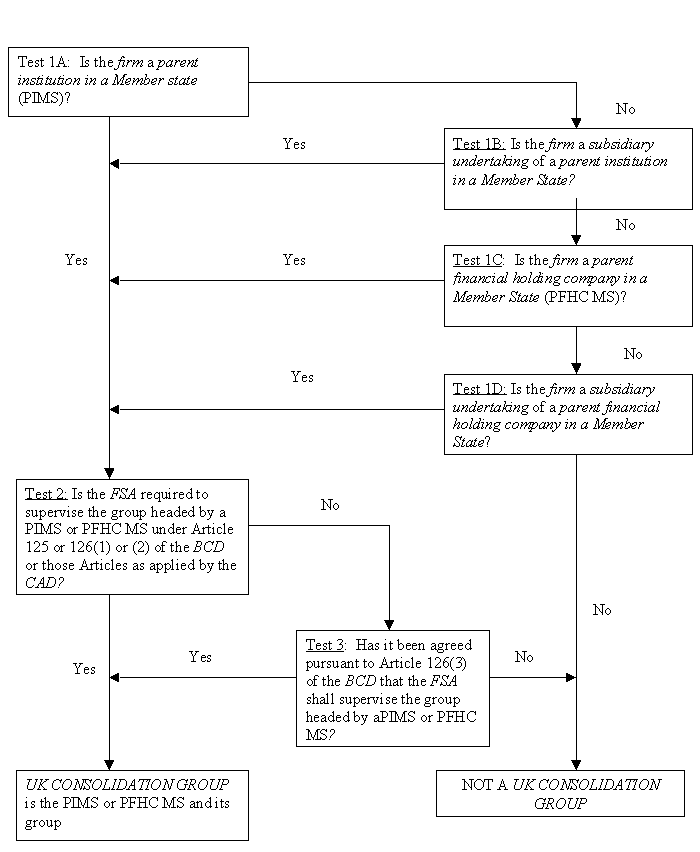
- 01/01/2007
BIPRU 8 Annex 2
Examples of how to identify a UK consolidation group
- 01/01/2007
See Notes

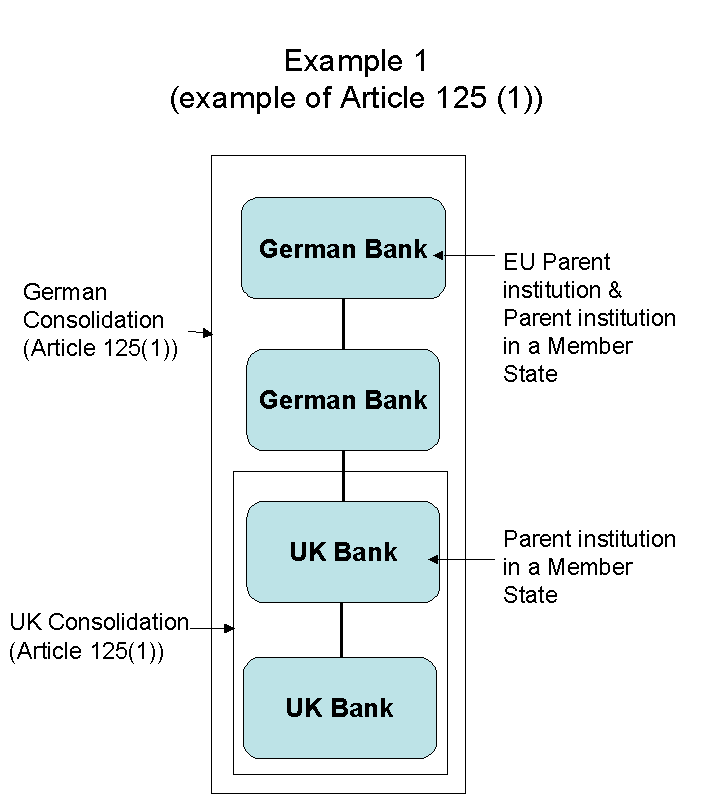

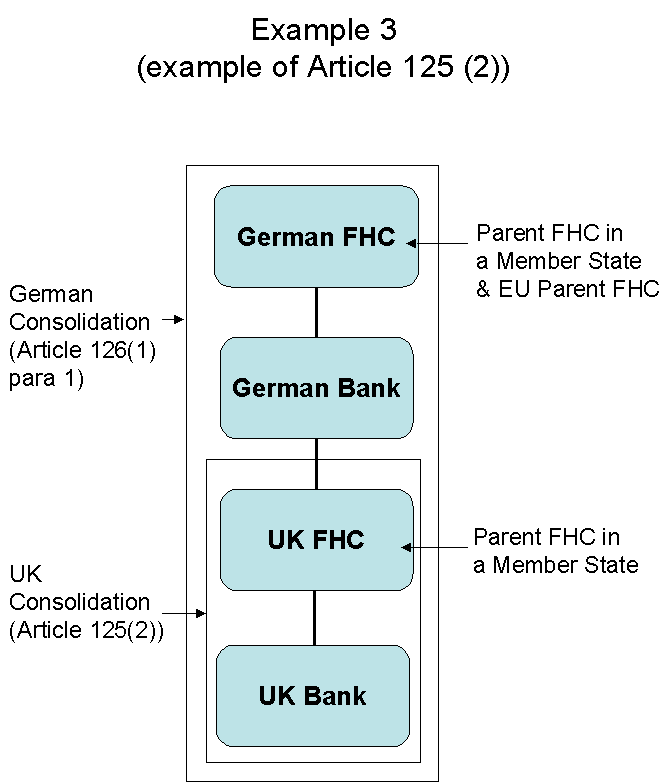
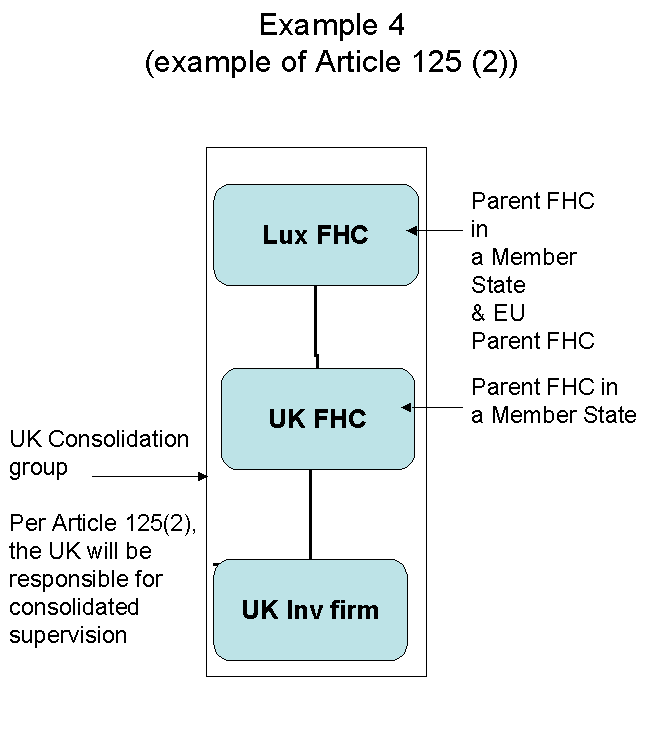
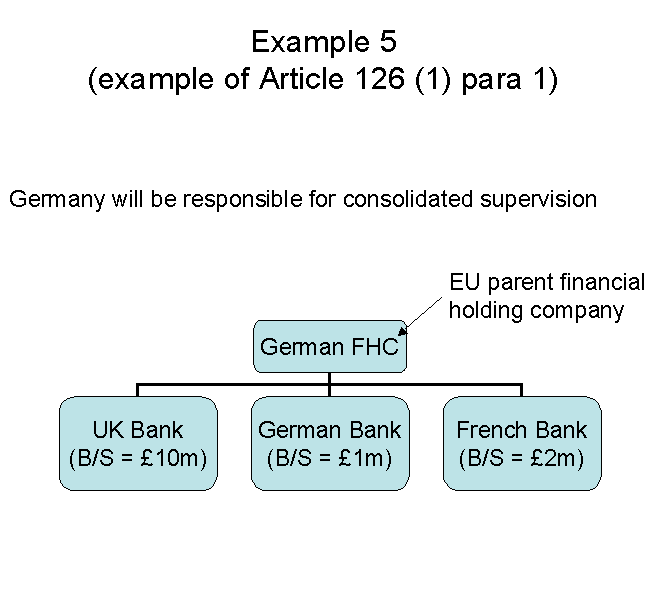

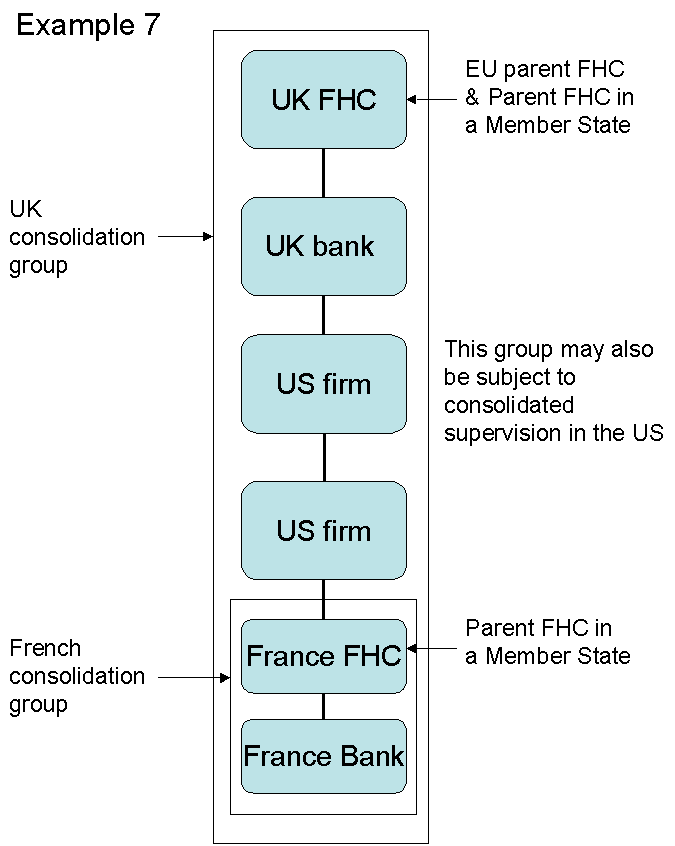
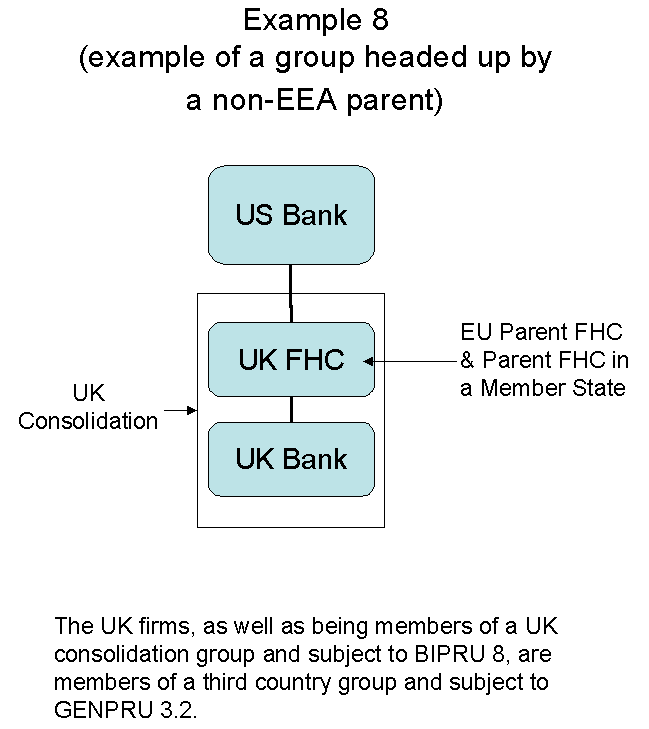
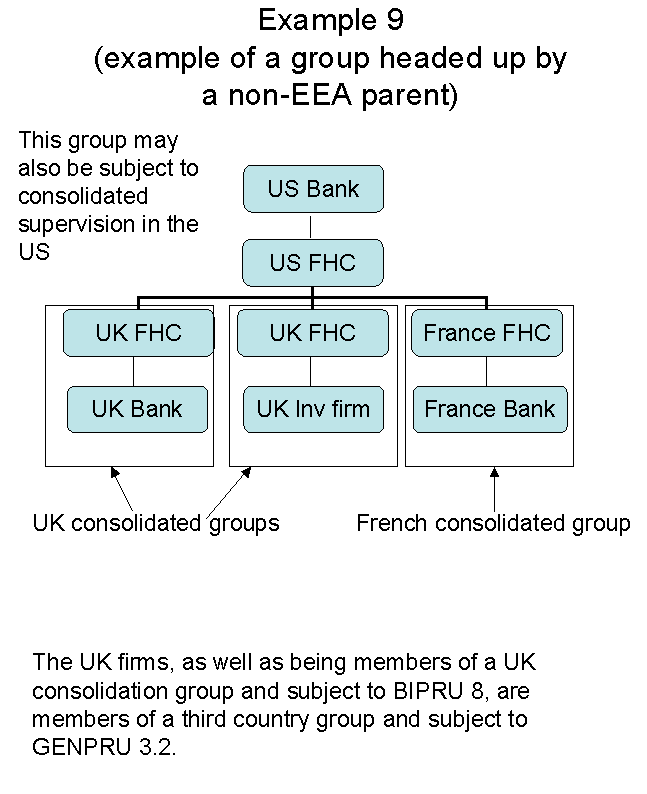
- 01/01/2007
BIPRU 8 Annex 3
Examples of how to identify a non-EEA sub-group
- 01/01/2007
See Notes

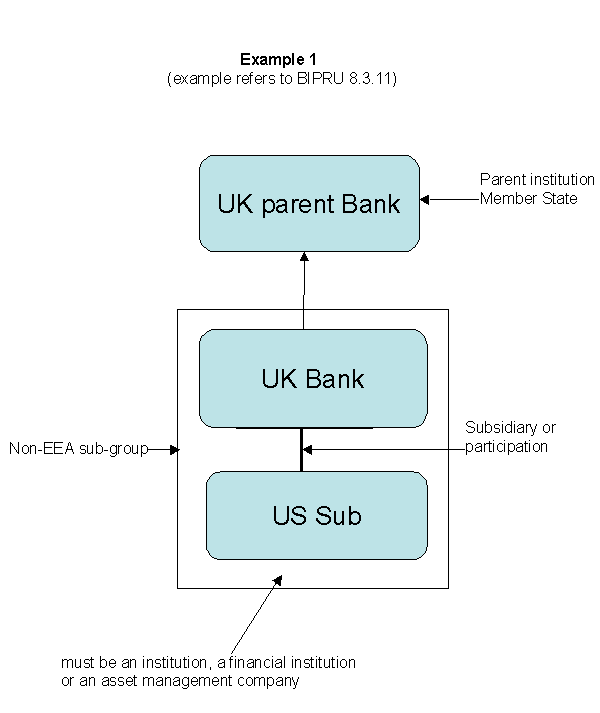



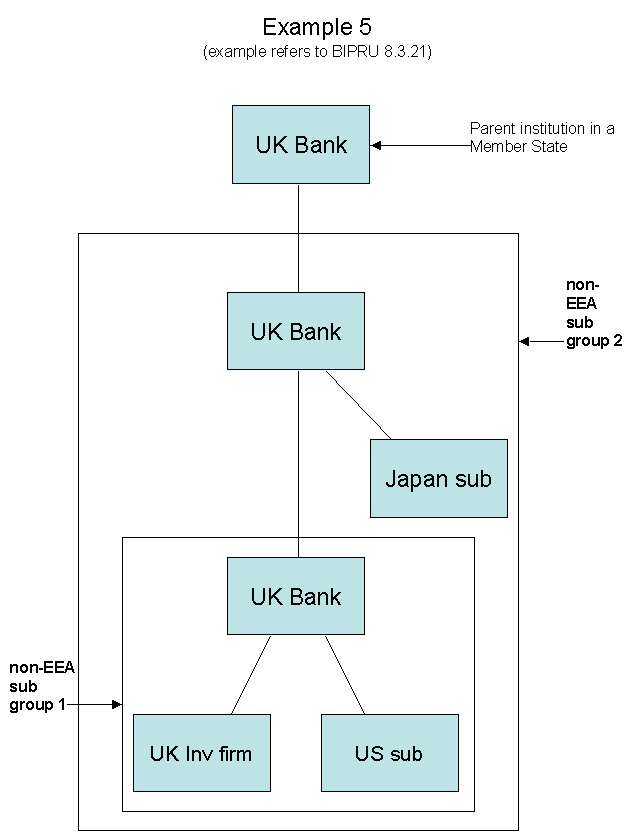
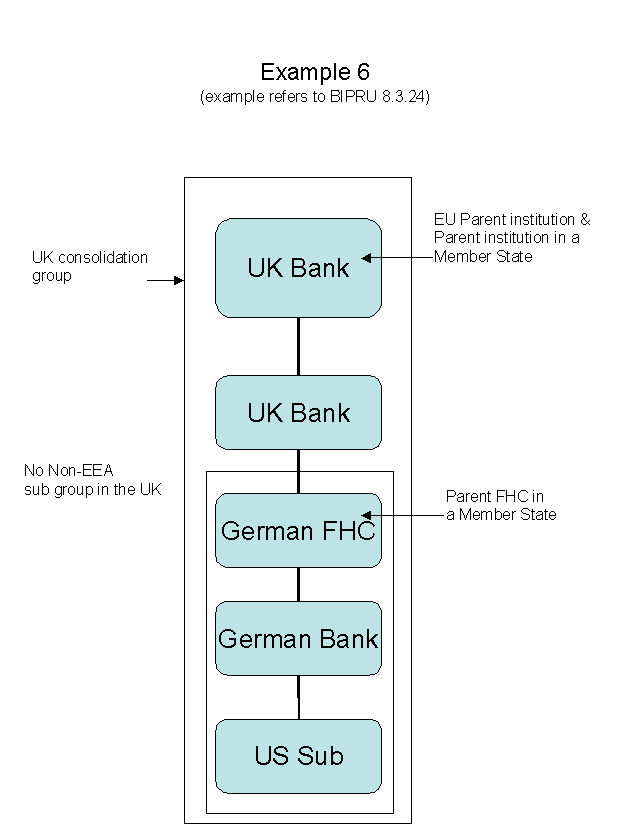
- 01/01/2007
BIPRU 8 Annex 4
Text of Articles 125 and 126 of the Banking Consolidation Directive
- 01/01/2007
See Notes

| Article 125 | ||
| 1. | Where a parent undertaking is a parent credit institution in a Member State or an EU parent credit institution, supervision on a consolidated basis shall be exercised by the competent authorities that authorised it under Article 6. | |
| 2. | Where the parent of a credit institution is a parent financial holding company in a Member State or an EU parent financial holding company, supervision on a consolidated basis shall be exercised by the competent authorities that authorised that credit institution under Article 6. | |
| Article 126 | ||
| 1. | Where credit institutions authorised in two or more Member States have as their parent the same parent financial holding company in a Member State or the same EU parent financial holding company supervision on a consolidated basis shall be exercised by the competent authorities of the credit institution authorised in the Member State in which the financial holding company was set up. | |
| Where the parents of credit institutions authorised in two or more Member States comprise more than one financial holding company with head offices in different Member States and there is a credit institution in each of these States, supervision on a consolidated basis shall be exercised by the competent authority of the credit institution with the largest balance sheet total. | ||
| 2. | Where more than one credit institution authorised in the Community has as its parent the same financial holding company and none of these credit institutions has been authorised in the Member State in which the financial holding company was set up, supervision on a consolidated basis shall be exercised by the competent authority that authorised the credit institution with the largest balance sheet total, which shall be considered, for the purposes of this Directive, as the credit institution controlled by an EU parent financial holding company. | |
| 3. | In particular cases, the competent authorities may by common agreement waive the criteria referred to in paragraphs 1 and 2 if their application would be inappropriate, taking into account the credit institutions and the relative importance of their activities in different countries, and appoint a different competent authority to exercise supervision on a consolidated basis. In these cases, before taking their decision, the competent authorities shall give the EU parent credit institution, or EU parent financial holding company, or credit institution with the largest balance sheet total, as appropriate, an opportunity to state its opinion on that decision. | |
| 4. | [Omitted] | |
| Note | The Capital Adequacy Directive says that generally references in Articles 125 and 126 of the Banking Consolidation Directive to credit institution should be read as including ones to CAD investment firms. Also, the Banking Consolidation Directive and the Capital Adequacy Directive apply to the EEA. Therefore for the purposes of BIPRU 8 Articles 125 and 126 of the Banking Consolidation Directive should be read with the following adjustments: | |
| (1) | a reference to a credit institution should be read as being one to a credit institution or CAD investment firm; | |
| (2) | a reference to a parent credit institution in a Member State should be read as being one to a parent institution in a Member State; | |
| (3) | a reference to a EU parent credit institution should be read as being one to an EEA parent institution; | |
| (4) | a reference to a EU parent financial holding company should be read as being one to an EEA parent financial holding company; | |
| (5) | a reference to a Member State should be read as being one to an EEA State; | |
| (6) | a reference to a credit institution authorised in the Community should be read as being to a credit institution or CAD investment firm authorised in an EEA State. | |
| Parent financial holding company in a Member State and financial holding company have the same meaning as they do in the Glossary. | ||
- 01/01/2007
BIPRU 8 Annex 5
Decision tree for identifying the consolidated capital resources requirement of a UK consolidation group or a non-EEA sub-group.
- 01/01/2007
See Notes

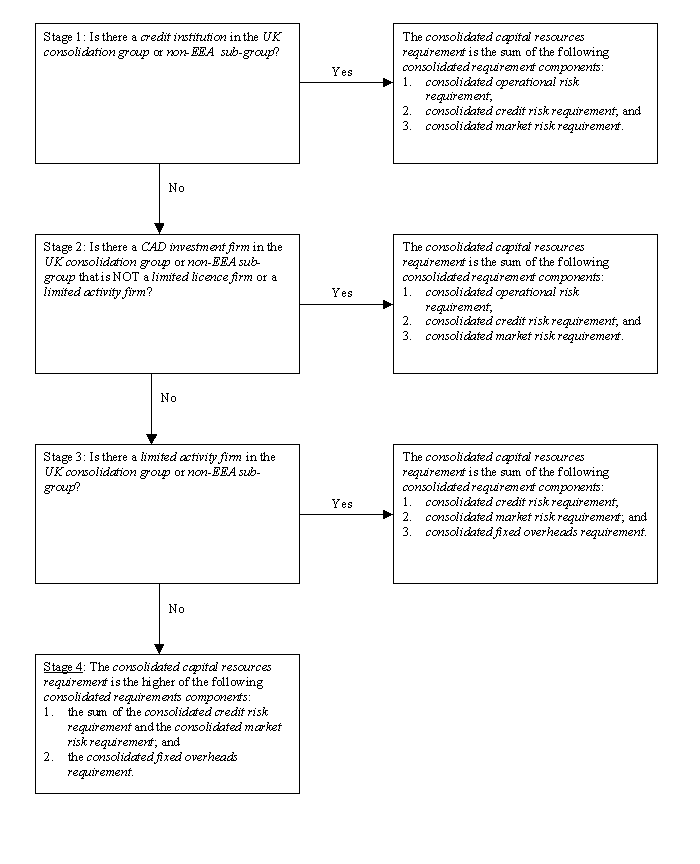
- 01/01/2007
BIPRU 8 Annex 6
Non-EEA regulators' requirements deemed CRD-equivalent for individual risks
- 01/01/2007
See Notes

| Part 1 (Non-EEA banking regulators' requirements deemed CRD-equivalent for individual risks) | |||
| Regime regulators | Market risk |
Credit
risk | Operational Risk |
|
USA
Office of the Comptroller of the Currency Board of Governors of the Federal Reserve System * a US banking subsidiary will be deemed equivalent for credit risk if: • it is categorised as well capitalised: and•it scales up its US Basel 1 credit risk requirement by 25% | √ √ | X* X* | X X |
|
Australia
Australian Prudential Regulation Authority [APRA] | √ | √ | X |
|
Canada
Office of the Superintendent of Financial Institutions [OSFI] | √ | √ | √ |
|
Switzerland
Swiss Federal Banking Commission [EBK] | √ | √ See note 2 | √ |
|
Japan
Financial Services Agency, Japan [JFSA] | √ | X | X |
|
South Africa
South African Reserve Bank [SARB] | √ | √ | √ |
|
Hong Kong
Hong Kong Monetary Authority [HKMA] | √ | √ | √ |
|
Singapore
Monetary Authority of Singapore [MAS] | √ | √ | √ |
|
India
Reserve Bank of India [RBI] | √ | √ | √ |
|
Korea
Financial Supervisory Service [FSS] | √ | X | X |
| Jersey | √ | √ | √ |
| Guernsey | X | √ | √ |
| Isle of Man | X | √ | √ |
| Note 1: A √ denotes that the requirements have been assessed as equivalent to EEA standards. A X denotes that the requirements have been assessed as not being equivalent to EEA standards. | |||
| Note 2: √ International standardised approach only. The treatment of the Lombard loans is not equivalent and they must be treated under the FSA's rules. | |||
| Part 2 (Non-EEA investment firm regulators' requirements deemed CRD-equivalent for individual risks) | |||
| Regime regulators | Market risk | Credit risk | Operational Risk |
|
Australia
Sydney Futures Exchange Australian Stock Exchange | √ √ | X X | X X |
|
Canada
Ontario Securities Commission Quebec Securities Commission British Columbia Securities Commission Alberta Securities Commission Investment dealers Association of Canada | √ √ √ √ √ | X X X X X | X X X X X |
|
Hong Kong
Hong Kong Monetary Authority [HKMA] Hong Kong Securities and Futures Commission | √ √ | X X | X X |
|
Japan
Financial Services Agency, Japan [JFSA] | √ | X | X |
|
Singapore
Monetary Authority of Singapore [MAS] Stock Exchange of Singapore | √ √ | X X | X X |
|
South Africa
South African Futures Exchange Johannesburg Stock Exchange Bond Exchange of South Africa | √ √ √ | X X X | X X X |
|
Switzerland
Swiss Federal Banking Commission [EBK] | √ | √ Note 2 | √ |
|
USA
Securities & Exchange Commission (SEC): Net Capital rule only Commodities and Futures Trading Commission | √ Note 3 √ | √ X | X X |
| Note 1: A √ denotes that the requirements have been assessed as equivalent to EEA standards. A X denotes that the requirements have been assessed as not being equivalent to EEA standards. | |||
| Note 2: √ International standardised approach only. The treatment of Lombard loans is not equivalent and they must be treated under the FSA's rules. | |||
| Note 3: √ Where entities are subject to a local regulatory capital requirement. | |||
- 01/01/2007
